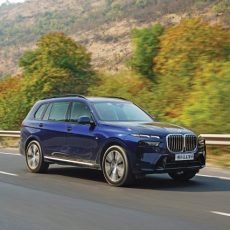The hybrid’s battery is stowed behind the rear seat, yet there is generous boot space. This car is not really meant to be the epitome of comfort and luxury, but for the numerous cutting edge technologies it holds under the hood. The Prius is a power split or combined hybrid vehicle that can be propelled by gasoline and/or electric power. Essentially, the Prius runs on not one but three motors. The first is the 1.8-litre petrol engine that produces 101Ps and 142 Nm of torque and the other two are electrical motors. The first can be broadly termed as a motor for propelling and the other a generator and both the electric engines produce 81Ps and 206Nm torque which charges a 36bhp, nickel-metal hydride battery. The three motors combined together using the hybrid system can churn out a net output of 135Ps.
Toyota uses the Hybrid Synergy Drive (HSD) on the Prius, which in simple terms manages the right balance between the petrol engines and the electric motors. It helps in increasing torque by kicking in the electric motor and so reduces the engine speeds or rpm, which in turn increases fuel economy. The HSD adjusts and blends the amount of power from the petrol engine and electric motors as needed by the front drive wheels and rechargeable batteries. Okay, I have made it sound too simple, but trust me its a whole lot of complicated interlinked technologies working in absolute harmony. The information display on the dashboard shows the energy flow diagram of the Prius, so that you know which motor is in use and when the battery is getting charged.
The red arrow depicts the petrol power and the white indicates the battery. But I really had to strain my eyes to follow the red arrow under the glaring Indian sun. You can use the steering mounted controls to toggle between an array of other graphs representing energy regenerated, fuel consumption, etc. You get a keyless entry into the car. Push the power button and the Prius silently comes alive because there is no conventional starter. Place the gear selector into Drive mode and still no roaring of the engine. Press the accelerator and off you go, still so silent that it will shock you in disbelief. The feeling is almost magical. This is because at low speeds the HSD switches to its efficient electric motor. Slam the accelerator and the petrol engine joins in discreetly pushing you back into the seat with the sudden surge of power. You won’t realize the transition till you look at the energy flow diagram on the dashboard display. You have the option to manually choose the drive mode between Power, Eco and EV (only electric) mode.
In the Eco mode, the gas pedal sensitivity is reduced to enhance fuel economy and the opposite happens in the Power mode to keep the speed junkies content. However, the EV mode can be selected below 55km/h when the battery has adequate charge. The steering comes across to be soft, but is responsive and precise. We couldn’t help but drive the Prius on some pure Indian potholed roads and found the suspension to be a bit stiff. But on better roads, the drive was very comfortable and hardly tiring. Initially, I was disappointed with the spongy response I got from the brake pedal, but the braking figure during the performance test was impressive. The transition from the regenerative braking to regular disc is also unnoticeable. It managed naught to 100km/h in just over 11 seconds, which can easily take on several other regular sedans.
Once you get used to the radical bits and peculiarities of the car then this is one hybrid you would like to drive around in. But even after shelling out Rs 34 lakh (thanks to the ridiculous Indian tax structure, which doesn’t even give the hybrid a subsidy) for the boot full of intelligent technologies you might remain disappointed because the Prius does not have some very basic features. Going back to the first few lines of this article, you will notice that I had to manually shut the outer RVMs. You also don’t get park assist, sat-nav or even electrically adjustable seats as standard. So, is it better than owning an efficient diesel powered sedan for half the price? Well, here’s the most important aspect of the hybrid – fuel efficiency. The Prius achieved 14kmpl in the city and an outstanding 24kmpl on the highway! When coupled with the zero emission EV mode this would mean checkmate! But if you are ready to spend so much for a hybrid in the first place then probably you already have a few of those regular sedans stashed in your garage. So, if you want to announce your concern for global warming, the Prius is the ultimate investment for your ‘greens’.





